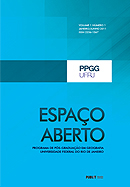Interactions between Geography and Environmental Education: The Case of the Mamirauá Sustainable Development Reserve in the Brazilian Amazon
DOI:
https://doi.org/10.36403/espacoaberto.2019.24343Keywords:
Geography, Environmental Education, Environmental Crisis, Mamirauá Sustainable Development Reserve, Brazilian Amazon.Abstract
This article is a bibliographical review of the interaction between the fields of geography and environmental education in response to the contemporary environmental crisis. The environment as a matrix for geographic thought, environmental education as science, environmentalism as a social movement and the possible contributions of geographic knowledge to the field of environmental education are highlighted. Based on the proposal of geographical method offered by Becker & Gomes (1993), a critical analysis of sustainable development as a logistic model for ordering territorial use is developed here. To this end, the implementation of the Mamirauá Sustainable Development Reserve in the Brazilian Amazon at the end of the 20th century is discussed with an emphasis on the program of environmental education used in the conservation unit. The Mamirauá case is shown to be a concrete example of territorial governance that expresses a new rationality identified with the basic principles of sustainable development which uses environmental education as one of its basic strategies.Downloads
Download data is not yet available.
Downloads
Published
2019-05-14
How to Cite
PINTO, Vicente Paulo dos Santos. Interactions between Geography and Environmental Education: The Case of the Mamirauá Sustainable Development Reserve in the Brazilian Amazon. Espaço Aberto, Rio de Janeiro, Brasil, v. 9, n. 1, p. 111–127, 2019. DOI: 10.36403/espacoaberto.2019.24343. Disponível em: https://revistas.ufrj.br/index.php/EspacoAberto/article/view/24343. Acesso em: 7 dec. 2025.
Issue
Section
Articles
License
The copyright of articles published in Espaço Aberto belong to their respective authors with rights to first publication conceded to the journal. Every time that the article is cited and reproduced in institutional repositories or personal and professional web pages the link to the journal web page must be provided. The articles are simultaneously licensed under the Creative License Commons BY-NC-SA 4.0.



